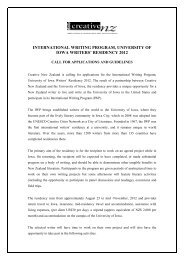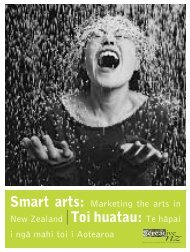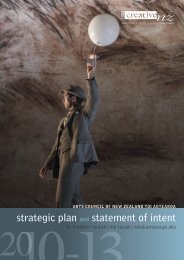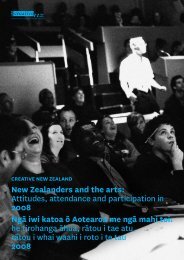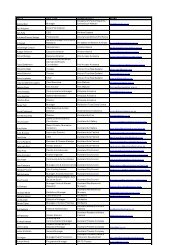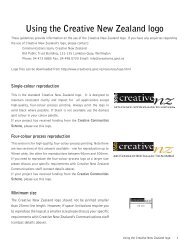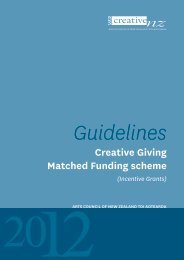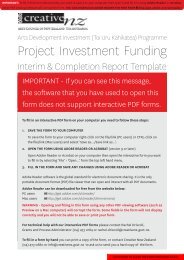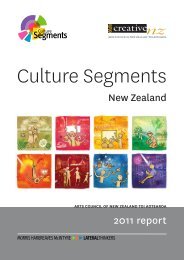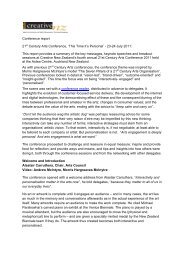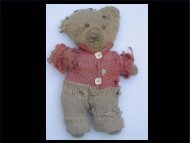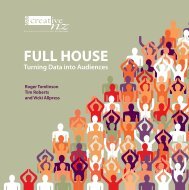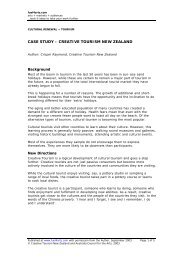relationship marketing – life in the trenches - Creative New Zealand
relationship marketing – life in the trenches - Creative New Zealand
relationship marketing – life in the trenches - Creative New Zealand
Create successful ePaper yourself
Turn your PDF publications into a flip-book with our unique Google optimized e-Paper software.
fuel4arts.com<br />
arts + markets + audiences<br />
…tools & ideas to take your work fur<strong>the</strong>r<br />
Relationship Market<strong>in</strong>g and <strong>the</strong> Arts<br />
Arts marketers know that <strong>the</strong>ir product has a number of unique characteristics<br />
that require different handl<strong>in</strong>g than traditional consumer products. These<br />
characteristics are ideally suited to a <strong>relationship</strong> <strong>market<strong>in</strong>g</strong> approach.<br />
Art is Intangible<br />
The experience of art is <strong>in</strong>tangible; <strong>the</strong>re is no ever last<strong>in</strong>g physical product.<br />
Once <strong>the</strong> curta<strong>in</strong> falls <strong>the</strong> show has gone for ever. Sure, you could come back to<br />
see <strong>the</strong> same show <strong>the</strong> follow<strong>in</strong>g night, but <strong>the</strong> experience will always be<br />
different. The visual arts are <strong>the</strong> same. Even though <strong>the</strong> work itself has a physical<br />
form, <strong>the</strong> real value is ultimately derived from <strong>the</strong> emotion that it stirs with<strong>in</strong> <strong>the</strong><br />
person gaz<strong>in</strong>g upon it, ra<strong>the</strong>r than physical ownership. Relationship <strong>market<strong>in</strong>g</strong> is<br />
an opportunity for arts marketers to enhance <strong>the</strong> emotional experience that <strong>the</strong>ir<br />
customers receive.<br />
Arts Involves Individual Interpretation<br />
Art is a personal journey. We all come from different backgrounds and all have<br />
vastly different collections of <strong>life</strong> experiences. An artistic work asks each<br />
<strong>in</strong>dividual to <strong>in</strong>terpret what it is present<strong>in</strong>g to us. The context for each <strong>in</strong>dividual’s<br />
<strong>in</strong>terpretation comes from <strong>the</strong> knowledge and experience <strong>the</strong>y have ga<strong>the</strong>red<br />
over <strong>the</strong>ir <strong>life</strong>time <strong>–</strong> this is why we all have different op<strong>in</strong>ions. Relationship<br />
<strong>market<strong>in</strong>g</strong> acknowledges that we are all different and recognises <strong>the</strong> need to<br />
provide an <strong>in</strong>formation system that caters to <strong>the</strong>se differences.<br />
Art Appeals to All<br />
Arts <strong>market<strong>in</strong>g</strong> is about access, enabl<strong>in</strong>g <strong>the</strong> greatest possible slice of <strong>the</strong><br />
population to experience what we have to offer. This means an arts organisation’s<br />
potential customers are of all ages and come from a range of cultural and<br />
educational backgrounds.<br />
Given this diverstity of backgrounds, <strong>the</strong> <strong>in</strong>formation required by customers for<br />
<strong>the</strong>m to make <strong>the</strong> decision to attend, and <strong>the</strong>n to maximise <strong>the</strong> personal benefit<br />
<strong>the</strong>y ga<strong>in</strong> from <strong>the</strong> experience, will vary immensely from person to person.<br />
Therefore arts orga<strong>in</strong>sations need a strategy that acknowledges that <strong>the</strong>y have a<br />
wide base of potential customers and enables <strong>the</strong>m to provide specific<br />
<strong>in</strong>formation to <strong>in</strong>dividual customers.<br />
The Enterta<strong>in</strong>ment Industry and Spend<strong>in</strong>g More Effectively<br />
“In fact, some marketers claim that as a result of chang<strong>in</strong>g households, complex<br />
products, new ways to shop and pay, <strong>in</strong>tense competition, and decl<strong>in</strong><strong>in</strong>g<br />
advertis<strong>in</strong>g effectiveness, mass <strong>market<strong>in</strong>g</strong> is obsolete.”<br />
- Kotler and Scheff, 1997.<br />
From sports and movies, to a night <strong>in</strong> watch<strong>in</strong>g <strong>the</strong> telly, <strong>the</strong> arts are now up<br />
aga<strong>in</strong>st all activities that people have to choose from <strong>in</strong> <strong>the</strong>ir leisure time. Arts<br />
marketers need to develop smarter and more adaptable tools to be able to match<br />
it with competitors with far greater resources.<br />
In an <strong>in</strong>creas<strong>in</strong>gly expensive marketplace marketers must be able to measure <strong>the</strong><br />
effectiveness of <strong>the</strong> tools and mediums <strong>the</strong>y are us<strong>in</strong>g. Traditional mass mediums<br />
such as pr<strong>in</strong>t advertis<strong>in</strong>g, radio and television are undoubtedly effective tools for<br />
rais<strong>in</strong>g awareness but research shows that awareness alone is not enough to send<br />
customers scurry<strong>in</strong>g to <strong>the</strong> box office.<br />
Published at www.fuel4arts.com with permission from <strong>the</strong> Author, July 2003 Page 2 of 6<br />
© Penn Trevella and Australia Council for <strong>the</strong> Arts, 2003



